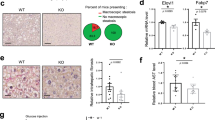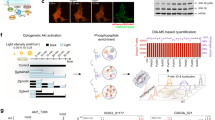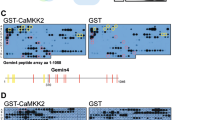Abstract
Ataxia telangiectasia (AT) is a human hereditary syndrome whose underlying gene product, ataxia telangiectasia mutated (ATM) protein kinase, is involved in multiple intracellular signaling pathways. We demonstrated previously that AT fibroblasts are defective in intracellular Ca2+ mobilization in response to both stress-inducing and mitogenic stimuli. To extend these findings, normal and AT cells were exposed to serum in the presence of different concentrations of extracellular Ca2+ ([Ca2+]o), and release of intracellular Ca2+, activation of calmodulin-dependent protein kinase II and phosphorylation of kinases ERK1 and 2 were monitored. When maintained in high [Ca2+]o (0.42 mM), normal fibroblasts responded to serum introduction more rapidly and efficiently than did AT cells. Unexpectedly, decreasing the [Ca2+]o in the medium had a diametrically opposite effect. Under low [Ca2+]o (0.0022 mM) conditions, normal cells were slow and inefficient in their responses, whereas AT cells showed a substantial improvement in all three end points. These findings demonstrate that loss of ATM kinase function deregulates the extracellular calcium-sensing receptor (CaR). This malfunction presumably arises from a post-transcriptional event, since CaR mRNA proved to be normal in AT cells. Together, our data suggest that ATM may mediate cell response to mitogenic factors by tightly regulating the set point of the CaR and thereby modulating the crosstalk between this metabotropic receptor and growth factor receptors. Alternatively, the faulty sensing of extracellular calcium in AT cells may be secondary to a state of chronic oxidative stress attributable to ATM deficiency.
This is a preview of subscription content, access via your institution
Access options
Subscribe to this journal
Receive 50 print issues and online access
$259.00 per year
only $5.18 per issue
Buy this article
- Purchase on Springer Link
- Instant access to full article PDF
Prices may be subject to local taxes which are calculated during checkout




Similar content being viewed by others
References
Berridge MJ, Lipp P and Bootman MD . (2000). Nat. Rev. Mol. Cell Biol., 1, 11–21.
Blume-Jensen P and Hunter T . (2001). Nature, 411, 355–365.
Brown EM . (2000). Annu. Rev. Nutr., 20, 507–533.
Chattopadhyay N . (2000). Int. J. Biochem. Cell Biol., 32, 789–804.
Chiesa N, Barlow C, Wynshaw-Boris A, Strata P and Tempia F . (2000). Neuroscience, 96, 575–583.
Durocher D and Jackson SP . (2001). Curr. Opin. Cell Biol., 13, 225–231.
Enns L, Murray D and Mirzayans R . (1999). Br. J. Cancer, 81, 959–965.
Falck J, Mailand N, Syljuasen RG, Bartek J and Lukas J . (2001). Nature, 410, 842–847.
Famulski KS and Paterson MC . (1999). FEBS Lett., 453, 183–186.
Fukao T, Kaneko H, Birrell G, Gatei M, Tashita H, Yoshida T, Cross S, Kedar P, Watters D, Khana KK, Misko I, Kondo N and Lavin MF . (1999). Blood, 94, 1998–2006.
Gueven N, Keating KE, Chen P, Fukao T, Khanna KK, Watters D, Rodeman F. J. PH and Lavin M . (2001). Biol. Chem., 276, 8884–8891.
Hall J and Angele S . (1999). Mol. Med. Today, 5, 157–164.
Heyer BS, MacAuley A, Behrendtsen O and Werb Z . (2000). Genes Dev., 14, 2072–2084.
Huang S, Maher VM and McCormick JJ . (1995). Biochem. J., 310, 881–885.
Kamsler A, Daily D, Hochman A, Stern N, Shiloh Y, Rotman G and Barzilai A . (2001). Cancer Res., 61, 1849–1854.
Keating KE, Gueven N, Watters D, Rodemann, HP and Lavin MF . (2001). Oncogene, 20, 4281–4290.
Lavin MF and Shiloh Y . (1997). Annu. Rev. Immunol., 15, 177–202.
McNeil SE, Hobson SA, Nipper V and Rodland KD . (1998a). J. Biol. Chem., 273, 1114–1120.
McNeil L, Hobson S, Nipper V and Rodland KD . (1998b). Am. J. Obstet. Gynecol., 178, 305–313.
Mirzayans R, Famulski KS, Enns L, Frazer M and Paterson MC . (1995). Oncogene, 11, 1597–1605.
Nagasawa H and Little JB . (1999). Radiat. Res., 52, 552–557.
Peretz S, Jensen R, Baserga R and Glazer PM . (2001). Proc. Natl. Acad. Sci.USA, 98, 1676–1681.
Pienkowska M, Brown K, Bakheet RH, Al-Hijailan RS, Al-Mohanna F, Paterson MC and Famulski KS . (2002). Cancer Detect. Prev., 26 (Suppl. 1), S–64 (abstr. 50).
Rotman G and Shiloh Y . (1999). Oncogene, 18, 6135–6144.
Shaywitz AJ and Greenberg ME . (1999). Annu. Rev. Biochem., 68, 821–861.
Soares HD, Morgan JI and McKinnon PJ . (1998). Neuro-science, 86, 1045–1054.
Speer G, Cseh K, Mucsi K, Takacs I, Dworak O, Winkler G, Szody R, Tisler A and Lakatos P . (2002). Int. J. Colorectal. Dis., 17, 20–24.
Squier TC . (2001). Exp. Gerontol., 36, 1539–1550.
Taylor AM . (1998). Int. J. Radiat. Biol., 73, 365–371.
Yan J, Khanna KK and Lavin MF . (2000). Int. J. Radiat. Biol., 76, 1025–1035.
Yang DQ and Kastan MB . (2000). Nat. Cell Biol., 2, 893–898.
Yazdi T, Wang Y, Zhao S, Patel N, Lee EY-HP and Qin J . (2002). Genes Dev., 16, 571–582.
Yordy JS and Muise-Helmericks RC . (2000). Oncogene, 19, 6503–6513.
Zhou B-BS and Elledge SJ . (2000). Nature, 408, 433–439.
Acknowledgements
We thank Dr S Pikula, (Nencki Institute of Experimental Biology, Warsaw, Poland) for his help with the calculations of free calcium concentrations. Excellent technical assistance of Mr Kevin Brown is gratefully acknowledged. This work was supported by King Faisal Specialist Hospital & Research Centre, RAC Research Project # 2010 005.
Author information
Authors and Affiliations
Corresponding author
Rights and permissions
About this article
Cite this article
Famulski, K., Al-Hijailan, R., Dobler, K. et al. Aberrant sensing of extracellular Ca2+ by cultured ataxia telangiectasia fibroblasts. Oncogene 22, 471–475 (2003). https://doi.org/10.1038/sj.onc.1206167
Received:
Revised:
Accepted:
Published:
Issue Date:
DOI: https://doi.org/10.1038/sj.onc.1206167
Keywords
This article is cited by
-
Cellular functions of the protein kinase ATM and their relevance to human disease
Nature Reviews Molecular Cell Biology (2021)
-
The ATM protein kinase: regulating the cellular response to genotoxic stress, and more
Nature Reviews Molecular Cell Biology (2013)



